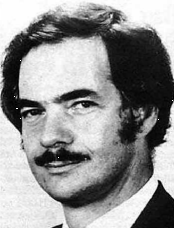Adam Osborne
Adam Osborne was known to frequent the famous Homebrew Computer Club's meetings around 1975. He was best known for creating the first commercially available portable computer, the Osborne 1, released in April 1981. It weighed 24.5 pounds (12 kg), cost US$1795—just over half the cost of a computer from other manufacturers with comparable features—and ran the popular CP/M 2.2 operating system. At its peak, Osborne Computer Corporation shipped 10,000 units of "Osborne 1" per month. For a time, it was a huge success. Osborne deserves credit for being one of the first personal computing pioneers to understand fully that there was a wide market of buyers who were not computing hobbyists: the Osborne 1 included word processing and spreadsheet software. This was amazing in an era when even business minded IBM refused to bundle hardware and software with their PCs, even going to the point of separately selling operating systems, monitors, and even cables for the monitor.
It is said that in 1983, Adam Osborne bragged about two advanced new computers his company was developing. These statements destroyed consumer demand for the Osborne 1, and the resulting inventory glut forced Osborne Computer to file for bankruptcy on September 13, 1983. This phenomenon, a pre-announcement of a new product causing a catastrophic collapse in demand for older ones, became known as the Osborne effect, but according to some new sources the real reason for Osborne Computer's bankruptcy was management errors.
Steve Jobs
Steven Paul Jobs (born February 24, 1955) is the American co-founder, Chairman, and CEO of Apple Inc. and the former CEO of Pixar Animation Studios.
In the late 1970s, Jobs, with Apple co-founder Steve Wozniak, created one of the first commercially successful personal computers. In the early 1980s, Jobs was among the first to see the commercial potential of the mouse-driven graphical user interface. After losing a power struggle with the board of directors in 1985, Jobs resigned from Apple and founded NeXT, a computer platform development company specializing in the higher education and business markets. NeXT's subsequent 1997 buyout by Apple Computer Inc. brought Jobs back to the company he co-founded, and he has served as its CEO since then. Steve Jobs was listed as Fortune Magazine's Most Powerful Businessman of 2007.
In 1986, he acquired the computer graphics division of Lucas film Ltd which was spun off as Pixar Animation Studios. He remained CEO and majority shareholder until its acquisition by the Walt Disney Company in 2006. Jobs is currently the Walt Disney Company's largest individual shareholder and a member of its Board of Directors. He is considered a leading figure in both the computer and entertainment industries.
Jobs' history in business has contributed greatly to the myths of the idiosyncratic, individualistic Silicon Valley entrepreneur, emphasizing the importance of design and understanding the crucial role aesthetics play in public appeal. His work driving forward the development of products that are both functional and elegant has earned him a devoted following.
Jobs is currently on a leave of absence from Apple due to health issues.
Henry Edward Roberts
Ed Roberts (born 1942) was the founder and former president of Micro Instrumentation and Telemetry Systems (MITS) which built the Altair 8800, one of the very first hobbyist personal computers.
He grew up in Miami, Florida, where he attended the University of Miami and majored in electrical engineering. He joined the Air Force in 1962, and stayed in the service for 10 years, finding enough time along the way to finish his engineering degree at Oklahoma State University
As a teenager, he created circuitry for analog and digital computers. A member of the United States Air Force, he earned his bachelor's degree in electrical engineering from Oklahoma State University, and was assigned to an Air Force base in San Antonio, Texas, where in his spare time he established two electronics companies, Reliance Engineering and Reliable Radio and TV.
In 1968, he was assigned to the research laboratory division of Kirtland Air Force Base in New Mexico, where he met Forrest Mims III. Reunited with a college friend Stan Cagle and an officer Bob Zaller, the four established MITS to sell rocket telemetry systems for hobbyists. In the fall of 1970, the company split up over a disagreement about the direction of the company, as Roberts wanted to start producing calculators, while Cagle and Mims wanted to create an infrared alarm system. Roberts and a friend bought out Cagle and Mims, although Mims would later return to write technical manuals.
Roberts wrote a featured article in the November 1971 issue of Popular Electronics about the MITS 816 calculator kit, and the business began to earn a profit. By 1974, however, competing companies were making the kits obsolete, so Roberts created the Altair 8800 and wrote a related article that was featured on the cover of the January 1975 issue of Popular Electronics. This article excited a Harvard University undergraduate named Bill Gates, and his good friend Paul Allen, and the duo contacted Roberts to write a BASIC interpreter for the machine. Roberts agreed to hire them, and Gates dropped out of Harvard. Later, Gates and Allen would leave MITS to begin a company called MicroSoft. The article would also inspire the creation of the Homebrew Computer Club by a group of Altair 8800 enthusiasts, and from this club emerged twenty-three computer companies, including Apple Computer (now known as Apple, Inc.).
In 1977, MITS was bought by Pertec Computer Corporation for upwards of $6 million, and Roberts entered medical school at Mercer University. He is now a country doctor in Cochran, Georgia.



